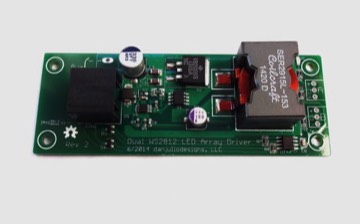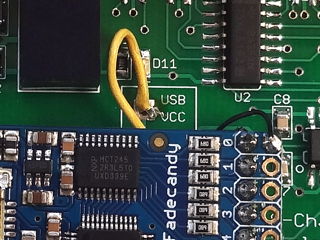Isolated WS2812 strip driver


I designed, as part of the Luminescence project, a pair of boards to allow a Fade Candy controller to drive remote WS2812 LED strips at distances of up to approximately 100 feet (30 meters). These boards can also be used with other controllers such as the Teensy 3.2 running the OctoWS2811 driver.
The OctoController board contains the Fade Candy and converts the logic-level output signals into differential pairs driven over 4 wires in a standard Cat-5 ethernet cabling. It also provides connection for a 24VDC power supply to supply power over the other 4 wires in the cable. 24VDC was selected to meet the maximum current carrying capability of Cat-5 cabling. The differential data and power systems are electrically isolated from the Fade Candy and ESD protected. Each OctoController is connected to four DualDriver boards.
The DualDriver board contains a DC-DC converter to generate 5VDC at up to 30 watts for two WS2812 LED strips and a differential to TTL converter for the data. It also includes ESD protection.
The Hand Weavers Guild of Boulder County, who commissioned this design, graciously allowed me to release it as Open Source Hardware.
The OctoController board contains the Fade Candy and converts the logic-level output signals into differential pairs driven over 4 wires in a standard Cat-5 ethernet cabling. It also provides connection for a 24VDC power supply to supply power over the other 4 wires in the cable. 24VDC was selected to meet the maximum current carrying capability of Cat-5 cabling. The differential data and power systems are electrically isolated from the Fade Candy and ESD protected. Each OctoController is connected to four DualDriver boards.
The DualDriver board contains a DC-DC converter to generate 5VDC at up to 30 watts for two WS2812 LED strips and a differential to TTL converter for the data. It also includes ESD protection.
The Hand Weavers Guild of Boulder County, who commissioned this design, graciously allowed me to release it as Open Source Hardware.
Downloads and Links
Complete hardware design package for both boards including Eagle design files, gerber files and PDFs.
Links to Mouser shared BOMs with parts for each board. Not including the Fade Candy or jumper wire. In addition to the Mouser BOM, you need a Coilcraft SER1915L-153KL inductor that I bought directly from Coilcraft.
PDF versions of the schematic.
Important Notes


You must connect a wire between the VUSB pad in the "hacker port" on the bottom of the Fade Candy to the "USB VCC" connector on the OctoController PCB. This provides power for the Fade Candy half of the isolator chips U3 and U4.
Power for the other half of the U3 and U4, as well as the differential drivers, U1 and U2, is provided from the 24VDC power supply through VR1.
Power for the other half of the U3 and U4, as well as the differential drivers, U1 and U2, is provided from the 24VDC power supply through VR1.
Be careful with the RJ45 connectors. Shorts between the 24VDC power lines and data lines will destroy the ESD diodes and may damage the differential driver and receiver ships. We custom crimped our own cables because we used UV-stabilized cabling designed for outdoor systems. This cable was very stiff and overwhelmed the plastic retaining clip on the RJ45 plugs. We had a couple of times when someone would bump a cable while the system was powered causing it to partially come out of the socket. Somehow the connectors shorted the power to data lines and damaged the hardware. We ended up securely fastening the cables to the connectors.
Power Supply Selection
The system is designed for operation with 24VDC 8 A power supplies connected to the OctoController board. Each DualDriver board is designed to supply up to 6A (30W) to the LED strips with greater than 85% efficiency with a 24VDC input. They can also run with a 12VDC input at lower efficiency when using the optional "Aux" connector and custom Cat-5 cables containing only the data lines (no power lines). It is not advisable to connect 12VDC power supplies to the OctoController board because the current will exceed the maximum recommended for Cat-5 cabling.
We used power-factor corrected Meanwell SP-200 supplies in the Luminescence installation although I think these are now obsolete.
We used power-factor corrected Meanwell SP-200 supplies in the Luminescence installation although I think these are now obsolete.
